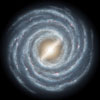
Hundreds of galaxies have been playing a cosmic game of hide and seek, and astronomers just tagged them “it”.
Using radio telescopes to peer through the dense plane of the Milky Way, researchers have spotted huge galactic gatherings that have long been obscured from view. These galaxies lie a mere 250 million light-years away—and they will only get closer, because they appear to be pulling us towards them at breakneck speed.
Scientists had suspected that galaxies existed in this region, says study co-author Renée C. Kraan-Korteweg of the University of Cape Town, South Africa. But seeing them with traditional telescopes presents a challenge.
“It was not really not that surprising, because the stars and dust in our own Milky Way block a not insignificant part of the sky from our view, in optical light that is,” she says. “So yes, we did expect that many galaxies would be lying behind the plane of the Milky Way, or the so-called Zone of Avoidance. However, we did not know anything about their distribution in space.”

For this study, the team added a special device called a multibeam receiver, which allowed them to conduct large-scale night sky surveys at a rate 13 times faster than previously possible. The effort identified 883 total galaxies, 240 of which hadn’t been seen before, the team reports this week in the Astronomical Journal.
This galactic cornucopia represents a huge amount of mass, which makes the team suspect that the objects play a role in the intergalactic draw of a strange region called the Great Attractor.
Decades ago, astronomers noted that our galaxy and its neighbors are headed towards a largely blank spot on the cosmic map at some 14 million miles an hour. That rate is not consistent with the speed at which the universe is thought to be expanding. Instead, the motion suggests something we can’t see is pulling us with the gravitational force of a million billion suns.
The authors suggest that the previously unseen galaxies may help explain where a lot of that mysterious mass comes from—hundreds of galaxies, each containing perhaps 100 billion stars, can exert a lot of pull.
“It seems that the Great Attractor consists of many galaxies and clusters of galaxies lying in a very large region of space,” says Lister Staveley-Smith of the University of Western Australia. “Just why such a large over density of galaxies lies in that region is a mystery, although cosmological theory does seem to confirm that, occasionally, such large mass concentrations should occur.
“Further follow-up studies are still required to quantify the mass that these galaxies seem to trace and see if this is in full agreement with what the Great Attractor suggested. But we are a major step closer in this endeavor.”
R. Brent Tully, an astronomer at the University of Hawaii in Honolulu, welcomes the new survey of what lies behind our galactic plane, but he feels that the mystery of the Great Attractor remains largely unanswered.
“The authors had wondered if perhaps this mystery might be resolved if there is some big stuff behind the galactic plane that would explain the peculiar velocity at which we are traveling towards it,” he says.
“So they did the survey and what they find is, yeah, there are hundreds of galaxies, but there’s nothing really super big back there. So unfortunately it doesn’t really change the big picture all that much or find the answer that we’re looking for, like finding something really outstanding behind the plane might.”
The array’s Widefield ASKAP L-Band Legacy All-Sky Blind Survey, or WALLABY, also aims to detect more than half a million more galaxies lurking beyond our home turf.
